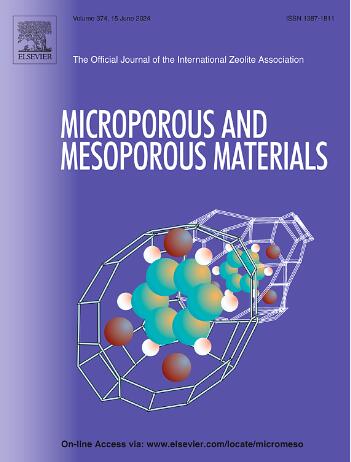The impact of Cu distribution in Cu/SAPO-34 catalyst on the continuous direct conversion of methane to methanol
IF 4.8
3区 材料科学
Q1 CHEMISTRY, APPLIED
引用次数: 0
Abstract
Direct oxidation of methane to methanol is a significant approach for utilizing natural gas and unconventional natural gas, reducing carbon emissions, and increasing energy efficiency. A series of Cu/SAPO-34 catalysts were successfully prepared using a simple and controllable solid ion exchange method for the continuous conversion of methane to methanol. The 1.5 wt% Cu/SAPO-34 achieves highest methanol yield of 178.3 μmol/(gcat·h), while maintaining a methanol selectivity of 47 % at 400 °C. The distribution of copper in the zeolite significantly affects its direct conversion of methane to methanol. Through ex-situ DRIFTS, EPR, and H2-TPR, all Cu/SAPO-34 catalysts contained two types of copper: one is isolated copper located on the hexagonal rings of the zeolite, which effectively conversion methane to methanol, and copper oxide nanoparticles in a cage, which easily cause over-oxidation of methanol. The in-situ DRIFTS confirmed the Cu2+-Cu+-Cu2+ redox cycle mechanism of the reaction.

Cu/SAPO-34催化剂中Cu分布对甲烷连续直接转化为甲醇的影响
甲烷直接氧化制甲醇是利用天然气和非常规天然气、减少碳排放和提高能源效率的重要方法。采用简单可控的固体离子交换法成功制备了一系列Cu/SAPO-34催化剂,用于甲烷连续转化为甲醇。在400℃时,1.5 wt% Cu/SAPO-34的甲醇收率最高,为178.3 μmol/(gcat·h),甲醇选择性为47%。铜在沸石中的分布对甲烷直接转化为甲醇有显著影响。通过移地漂移、EPR和H2-TPR,所有Cu/SAPO-34催化剂都含有两种类型的铜:一种是位于沸石六边形环上的分离铜,它能有效地将甲烷转化为甲醇;另一种是笼状的氧化铜纳米颗粒,它容易引起甲醇的过氧化。原位漂移实验证实了该反应的Cu2+-Cu+-Cu2+氧化还原循环机理。
本文章由计算机程序翻译,如有差异,请以英文原文为准。
求助全文
约1分钟内获得全文
求助全文
来源期刊

Microporous and Mesoporous Materials
化学-材料科学:综合
CiteScore
10.70
自引率
5.80%
发文量
649
审稿时长
26 days
期刊介绍:
Microporous and Mesoporous Materials covers novel and significant aspects of porous solids classified as either microporous (pore size up to 2 nm) or mesoporous (pore size 2 to 50 nm). The porosity should have a specific impact on the material properties or application. Typical examples are zeolites and zeolite-like materials, pillared materials, clathrasils and clathrates, carbon molecular sieves, ordered mesoporous materials, organic/inorganic porous hybrid materials, or porous metal oxides. Both natural and synthetic porous materials are within the scope of the journal.
Topics which are particularly of interest include:
All aspects of natural microporous and mesoporous solids
The synthesis of crystalline or amorphous porous materials
The physico-chemical characterization of microporous and mesoporous solids, especially spectroscopic and microscopic
The modification of microporous and mesoporous solids, for example by ion exchange or solid-state reactions
All topics related to diffusion of mobile species in the pores of microporous and mesoporous materials
Adsorption (and other separation techniques) using microporous or mesoporous adsorbents
Catalysis by microporous and mesoporous materials
Host/guest interactions
Theoretical chemistry and modelling of host/guest interactions
All topics related to the application of microporous and mesoporous materials in industrial catalysis, separation technology, environmental protection, electrochemistry, membranes, sensors, optical devices, etc.
 求助内容:
求助内容: 应助结果提醒方式:
应助结果提醒方式:


